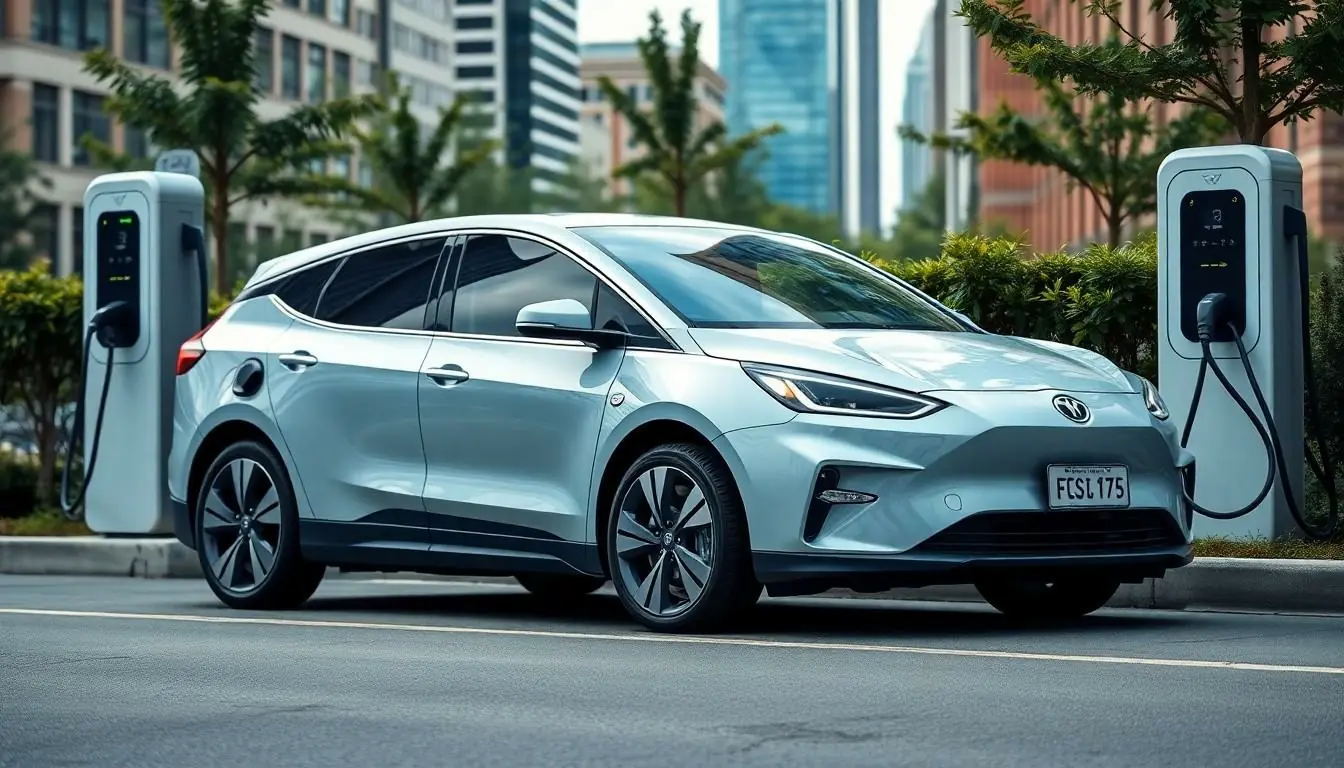Electric vehicles are taking the world by storm, and for good reason. They’re not just eco-friendly; they’re also packed with tech that makes driving feel like a scene from a sci-fi movie. Imagine gliding down the road in near silence while saving the planet—talk about a win-win!
Table of Contents
ToggleOverview Of Electric Vehicles
Electric vehicles (EVs) rely on electric motors powered by rechargeable batteries. These vehicles generate no tailpipe emissions, reducing air pollution and contributing to cleaner cities. Manufacturers design various types of EVs, including battery electric vehicles (BEVs) and plug-in hybrid electric vehicles (PHEVs).
The heart of an EV consists of its battery pack, which stores energy for the motor. Lithium-ion batteries dominate the market due to their efficiency and longevity. Effective management systems monitor battery health, ensuring safety and optimal performance.
Charging infrastructure plays a crucial role in the usability of electric vehicles. Public and private charging stations cater to different needs. Level 1 chargers provide a standard outlet charge, while Level 2 and DC fast chargers enable quicker refueling.
Regenerative braking enhances energy efficiency by recovering energy during braking. This process redirects energy back into the battery, extending the driving range. Automakers integrate cutting-edge technology to improve performance and user experience, making electric models increasingly attractive.
Additionally, EVs often feature advanced driver-assistance systems and connectivity options. These innovations enhance safety and convenience on the road. As the market expands, manufacturers continue to innovate, introducing new models with improved capabilities and appealing designs.
Recent data indicates that global electric vehicle sales reached over 6.4 million units in 2021, demonstrating significant growth. This trend reflects growing consumer interest in sustainable transportation and advancements in battery technology.
Key Components Of Electric Vehicles

Electric vehicles (EVs) consist of essential components that work together to create a seamless driving experience. Each component plays a crucial role in the operation and functionality of these eco-friendly machines.
Electric Motor
Electric motors convert electrical energy into mechanical energy, enabling the vehicle to move. These motors provide instant torque, allowing for rapid acceleration compared to traditional combustion engines. With fewer moving parts, electric motors enhance reliability and reduce maintenance needs. Some EVs utilize permanent magnet synchronous motors, while others may employ induction motors. Both types exhibit efficiency, translating battery power into propulsion effectively.
Battery Pack
Battery packs serve as the power source for electric vehicles. Typically, lithium-ion batteries are used due to their high energy density and longevity. A well-designed battery offers sufficient range, allowing drivers to travel significant distances between charges. Batteries undergo extensive testing to ensure safety and performance, with most packs featuring battery management systems that monitor charge levels and temperature. Manufacturers continuously innovate to improve battery life, cycle count, and charging speed, supporting the growing demand for EVs.
Charging System
Charging systems facilitate the replenishment of energy in electric vehicles. Different types of chargers exist, ranging from Level 1 chargers, which plug into standard outlets, to Level 3 DC fast chargers that provide rapid charging capabilities. Charging infrastructure continues to expand, promoting greater accessibility for EV owners. Smart charging technologies enable optimization of charging times based on grid demand, potentially reducing costs. These advancements support the trend where global electric vehicle sales surged to over 6.4 million units in 2021, reflecting increased consumer adoption.
How Electric Vehicles Operate
Electric vehicles utilize a rigorous system of power generation and energy storage to function effectively. Their design focuses on sustainability and efficiency, contributing to their rising popularity.
Power Generation
Electric motors ignite the driving experience for EVs, converting electrical energy into mechanical energy. Instant torque is available, allowing for swift acceleration. Motors operate quietly, enhancing the driving experience while generating zero tailpipe emissions. Most EVs draw energy from rechargeable batteries, primarily lithium-ion. This type of battery offers high energy density, significantly improving vehicle range. Additionally, power generation incorporates advanced electronics for optimal performance and efficiency.
Energy Storage
Lithium-ion battery packs serve as the core energy storage solution for electric vehicles. The architecture of these packs maximizes energy density, providing longer driving ranges and reducing the frequency of charging. EVs typically feature sophisticated battery management systems that monitor performance and ensure safety. Charging infrastructure accommodates various levels, enabling users to recharge at home or utilize public charging stations. Regenerative braking also captures energy during deceleration, redirecting it back to the battery for enhanced efficiency. Such innovations bolster the overall viability of electric vehicles in the global market.
Benefits Of Electric Vehicles
Electric vehicles (EVs) offer numerous benefits, making them an appealing choice for many consumers. First, environmental advantages rank high on the list. EVs produce zero tailpipe emissions, contributing to cleaner air in urban areas. Enhanced air quality leads to healthier communities.
Economic savings also come into play. Lower operating costs occur due to reduced fuel expenses and maintenance requirements. Charging an EV is generally cheaper than gasoline, and the longevity of lithium-ion batteries further decreases long-term costs.
Convenience plays a significant role in EV benefits. Home charging provides flexibility, making it easy to power vehicles overnight. Charging infrastructure continues to improve, with public charging stations growing in number and offering various options like fast chargers.
Safety features integrated with EVs stand out. Advanced driver-assistance systems (ADAS) contribute to improved road safety. Innovations in technology promote accident prevention, ensuring increased confidence for drivers and passengers alike.
Performance stands out as a noteworthy advantage. Electric motors deliver instant torque, resulting in rapid acceleration and a smooth driving experience. Many consumers appreciate how EVs handle well, offering responsive steering and control.
Tax incentives and rebates can also encourage EV adoption. Many regions offer financial benefits to new electric vehicle buyers, making the transition to sustainable transport more financially appealing.
Lastly, the growth of the EV market reflects changing consumer preferences. Over 6.4 million electric vehicles sold in 2021 signal a commitment to sustainable transportation. Manufacturers invest in developing new models with advanced features, highlighting an ongoing transformation in the automotive industry.
Challenges Facing Electric Vehicles
Electric vehicles encounter several challenges that could hinder their widespread adoption. Limited charging infrastructure presents a significant obstacle, as many regions lack adequate public charging stations. Availability of fast chargers is crucial for long-distance travel, yet these are often insufficient outside urban areas.
Range anxiety poses another issue for potential EV owners. Many consumers worry about the driving range of electric vehicles compared to traditional gasoline vehicles, despite advancements in battery technology. Manufacturers now produce models with ranges exceeding 300 miles, but the perception of limited range remains.
Battery costs contribute to the overall price of electric vehicles. While prices have declined over the past decade, high-quality lithium-ion batteries still represent a substantial portion of the vehicle’s cost. Innovations in battery recycling and alternative materials aim to address these expenses.
Charging time creates additional barriers. Standard home chargers may take hours to replenish a depleted battery, making it less convenient for drivers accustomed to quick gas fill-ups. Fast charging technology is evolving, yet faster options are not universally available.
Additionally, environmental concerns around battery production and disposal emerge. Lithium extraction and cobalt mining pose significant ethical and environmental issues. Increased focus on sustainable practices, paired with responsible sourcing and recycling initiatives, can mitigate these challenges.
Finally, consumer education plays a pivotal role in EV adoption. Many potential buyers remain unaware of the benefits and advancements in electric vehicle technology. Clarifying misconceptions and providing accurate information could significantly enhance public acceptance of EVs.
Electric vehicles represent a transformative shift in the automotive landscape. With their eco-friendly design and advanced technology, they offer a glimpse into the future of transportation. The integration of electric motors and lithium-ion batteries not only enhances performance but also contributes to cleaner urban environments.
As the EV market continues to grow, innovations in battery technology and charging infrastructure are addressing previous limitations. While challenges like charging accessibility and battery production remain, the benefits of electric vehicles are driving consumer interest and adoption.
The commitment to sustainable transportation is clearer than ever, and as awareness increases, electric vehicles are poised to play a significant role in shaping a greener future.



